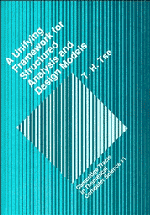 A Unifying Framework for Structured Analysis and Design Models
A Unifying Framework for Structured Analysis and Design Models Book contents
- Frontmatter
- Contents
- Preface
- List of Tables and Figures
- Chapter 1 Introduction
- Chapter 2 Desirable Features of Systems Development Environments
- Chapter 3 A Comparison with Related Work
- Chapter 4 An Initial Algebra Framework for Unifying the Structured Models
- Chapter 5 A Functorial Framework for Unifying the Structured Models
- Chapter 6 The Identification of Unstructuredness
- Chapter 7 A Prototype System to Implement the Unifying Framework
- Chapter 8 Conclusion
- Bibliography
- Index
Chapter 3 - A Comparison with Related Work
Published online by Cambridge University Press: 28 January 2010
- Frontmatter
- Contents
- Preface
- List of Tables and Figures
- Chapter 1 Introduction
- Chapter 2 Desirable Features of Systems Development Environments
- Chapter 3 A Comparison with Related Work
- Chapter 4 An Initial Algebra Framework for Unifying the Structured Models
- Chapter 5 A Functorial Framework for Unifying the Structured Models
- Chapter 6 The Identification of Unstructuredness
- Chapter 7 A Prototype System to Implement the Unifying Framework
- Chapter 8 Conclusion
- Bibliography
- Index
Summary
INTRODUCTION
In this chapter we shall compare our approach with five related systems development environments. These environments include PSL/PSA, ADS/SODA, SADT/EDDA, SAMM/SIGS and RSL/SREM. They have been chosen for comparison because of the following reasons:
(a) They were pioneer systems development environments meant to cover the entire systems life cycle, and have stood the test of time.
(b) They are better known and documented, so that interested readers can obtain further information easily.
(c) They are still under active development and recent enhancements have been reported.
(d) The languages examined cover a wide spectrum of characteristics. Some were originally developed as manual tools, but others were meant for mechanical support from the very beginning. For some languages, a system can be specified in a multi-level fashion, but not for others. Some languages use graphics as the specification medium while others are purely textual. Some of the development environments generate graphical feedback to users whereas others generate textual documentation.
(e) The final reason is a pragmatic one. We have included projects which are familiar to the present author. Part of this chapter is derived from the research results of a joint project with Mr Daniel Pong (Tse and Pong 1982, Tse and Pong (to appear)).
PSL/PSA AND META/GA
PSL was the first major language for defining a system formally and analysing it automatically (Teichroew 1971, Teichroew et al. 1980, 1982, PSL/PSA Introduction 1987).
Information
- Type
- Chapter
- Information
- A Unifying Framework for Structured Analysis and Design ModelsAn Approach Using Initial Algebra Semantics and Category Theory, pp. 19 - 34Publisher: Cambridge University PressPrint publication year: 1991